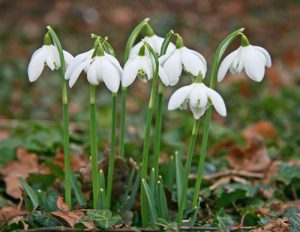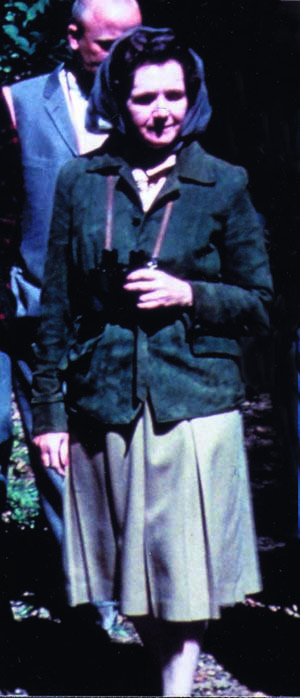Why Should We Care About Robins?
The return of robins in spring evokes the haunting power of Rachel Carson’s opening fable to Silent Spring, in which she writes lyrically about a town bereft of bird song. As Musil rejoices in this spring’s abundance of robins, he begins to trace the history of our interactions with the American Robin. Musil starts with the shift in consciousness about birds, signaled by the Migratory Bird Treaty Act of 1918. By the time Rachel Carson was a child, women conservationists and writers had built up a considerable Nature Study Movement that influenced Carson’s empathy for the wildlife around her. As this sense of empathy, and even the Migratory Bird Treaty Act, is threatened by the Trump Administration, Musil concludes that there is no better time than spring to seek renewal and the strength to fight for protection for all forms of life.
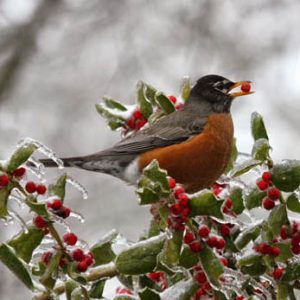
 The iconic American robin is both a winter resident and spring migrant where I live in Bethesda, Maryland. In winter, there are fewer in my yard and suburban neighborhood, but the robins, classic earthworm eaters, somehow make do with the berries found on bushes and on trees. This winter, when it was often cold and rainy, I watched with delight as robins hopped and jumped and dangled from the small branches of my backyard holly tree to get to and gobble its small clusters of bright red-orange berries.
The iconic American robin is both a winter resident and spring migrant where I live in Bethesda, Maryland. In winter, there are fewer in my yard and suburban neighborhood, but the robins, classic earthworm eaters, somehow make do with the berries found on bushes and on trees. This winter, when it was often cold and rainy, I watched with delight as robins hopped and jumped and dangled from the small branches of my backyard holly tree to get to and gobble its small clusters of bright red-orange berries.
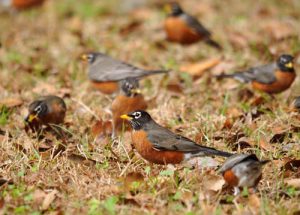 Then a little spring thaw in early March seemed to cause a sudden, miraculous explosion of robins everywhere. Lawns were covered with them as they listened, heads cocked to the ground, for the slithering sound of worms that would shortly be devoured. Trees were filled with them and their happy choruses of chuckles and “cheerilies.” I rushed excitedly to tell my wife, “The robins are here!” I had been searching for signs of spring after what has seemed a long, dreary, interminable winter without clear skies and with endless political sturm and drang.
Then a little spring thaw in early March seemed to cause a sudden, miraculous explosion of robins everywhere. Lawns were covered with them as they listened, heads cocked to the ground, for the slithering sound of worms that would shortly be devoured. Trees were filled with them and their happy choruses of chuckles and “cheerilies.” I rushed excitedly to tell my wife, “The robins are here!” I had been searching for signs of spring after what has seemed a long, dreary, interminable winter without clear skies and with endless political sturm and drang.
I took heart in February with the scraggly, yet beautiful, early yellow blossoms of witch hazel that appeared on the seemingly dead sticks of a bush near my home. I looked at and cherished each small bunch of snowdrops under my front azalea and on nearby lawns and pachysandra beds.
I had marveled at the first Red-winged blackbirds ever to land in my yard. A favorite childhood bird from the marshes on Long Island, I had recently heard a relative with a pond in her yard call them regular harbingers of spring. But for me, they were surprising, beautiful visitors, with their scarlet and gold wing patches, just passing through.
I have wondered before at the joy I feel at the return of robins, but in a more ominous context. The emotional power of Rachel Carson’s Silent Spring comes from her opening fable with its depiction of a town where no birds sing. The horrible impact of DDT can also be felt in her lucid, scientific explanation of how and why robins were shuddering and falling dead across America in the late 1950’s. Carson had been alerted by her friend Olga Hutchins of Duxbury, Massachusetts, about the death of robins around her home that she had turned into a bird sanctuary. Hutchins wrote vividly to the Boston papers and then sent the clipping to Rachel Carson urging her to take up the cause that would lead to Silent Spring. “We picked up three dead bodies the next morning by the door. They were birds that had lived with us, and built their nests in our trees year after year….On the following day one robin dropped suddenly from a branch in our woods. We were too heartsick to search for other corpses. All of these birds died horribly in the same way. Their bills were gaping open, and their splayed claws were drawn up to their breast in agony.”

 But why should we care about robins at all? And why would Olga Huckins and Rachel Carson react so strongly to the poisoning of a common, almost ubiquitous bird? Robins were first noticed by colonists in New England. They are said to have named them after the much smaller English robins or Robin redbreasts, an entirely different species (Erithacus rubecula) they recalled from home. The American Robin was first painted and described by the pioneer ornithologist, Mark Catesby, in the early seventeen hundreds. It was given its scientific name (Turdus migratorius) by Carl Linnaeus in 1766. Robins were then given widespread recognition by John James Audubon who featured and described them at length in his monumental volumes of Birds of America, printed between 1827 and 1838.
But why should we care about robins at all? And why would Olga Huckins and Rachel Carson react so strongly to the poisoning of a common, almost ubiquitous bird? Robins were first noticed by colonists in New England. They are said to have named them after the much smaller English robins or Robin redbreasts, an entirely different species (Erithacus rubecula) they recalled from home. The American Robin was first painted and described by the pioneer ornithologist, Mark Catesby, in the early seventeen hundreds. It was given its scientific name (Turdus migratorius) by Carl Linnaeus in 1766. Robins were then given widespread recognition by John James Audubon who featured and described them at length in his monumental volumes of Birds of America, printed between 1827 and 1838.
But for Audubon and for Americans of the early nineteenth century, robins were not only common, they were also considered a tasty meal to be shot in large numbers.
Their presence is productive of a sort of jubilee among the gunners, and the havoc made among them with bows and arrows, blowpipes, guns, and traps of different sorts, is wonderful. Every gunner brings them home by bagsful, and the markets are supplied with them at a very cheap rate. Several persons may at this season stand round the foot of a tree loaded with berries, and shoot the greater part of the day, so fast do the flocks of Robins succeed each other. They are then fat and juicy, and afford excellent eating.
The American Robin was not finally protected from slaughter until the Migratory Bird Treaty Act of 1918. That landmark environmental legislation grew out of a movement — beginning with a shift in consciousness about birds and shooting them that resulted from the growth of towns and cities, the end of the frontier, and, finally, a determined conservation campaign around the turn of the century led by women who loved and wanted to protect nature. As I wrote in Rachel Carson and Her Sisters, our first widely popular nature writer and environmentalist was Susan Fenimore Cooper whose 1850 book, Rural Hours, decried the loss of old-growth forests and the unceasing spread of towns. Cooper knew and had studied with noted biologists when she lived in Paris in the 1830s and later described in detail the flora and fauna of upstate New York, including the behavior of birds. She also was the first popular writer to describe the joy of the return of robins in the spring. “This morning to the joy of the whole community, the arrival of the robins is proclaimed. It is one of the great events of the year…No sooner is one of the first-comers seen by some member of the family that the fact is proclaimed through the house; children run to tell their parents, ‘The robins have come!’ Grandfathers and grandmothers put on their spectacles and step to the windows to look at the robins…”
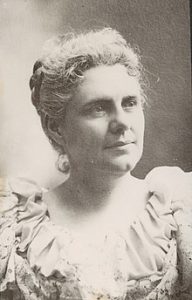 In her later years, Susan Fenimore Cooper joined with the younger women fighting to protect birds. By the time Rachel Carson was born in 1907, what was called “The Nature Study Movement,” was widespread. Carson’s mother raised her with curriculum by Anna Botsford Comstock, author of the Handbook of Nature Study, who taught that careful observation and a love of nature, developed by studying nature first-hand and outdoors, would create better, more empathetic and caring citizens — especially boys who were given to destroying nests and shooting birds. Olive Thorne Miller, a popular writer of the time, put it directly in her book The First Book of Birds (1899). “One who goes into the field to watch and study their ways will be surprised to find how like people they act. And after studying living birds, he will never want to kill them. It will seem to him almost like murder.” Yet another best-selling author, Neltje Blanchan, wrote in her Birds Every Child Should Know, published in 1907, the year Rachel Carson was born, “Interest in bird life exercises the sympathies. The child reflects something of the oriole whose ecstasy of song from the elm on the lawn tells the whereabouts of a dangling “cup of felt” with its deeply hidden treasures. He takes to heart the tragedy of a robin’s mud-plastered nest in the apple tree that was washed apart by a storm, and experiences something akin to remorse when he takes a mother bird from the jaws of his pet cat.”
In her later years, Susan Fenimore Cooper joined with the younger women fighting to protect birds. By the time Rachel Carson was born in 1907, what was called “The Nature Study Movement,” was widespread. Carson’s mother raised her with curriculum by Anna Botsford Comstock, author of the Handbook of Nature Study, who taught that careful observation and a love of nature, developed by studying nature first-hand and outdoors, would create better, more empathetic and caring citizens — especially boys who were given to destroying nests and shooting birds. Olive Thorne Miller, a popular writer of the time, put it directly in her book The First Book of Birds (1899). “One who goes into the field to watch and study their ways will be surprised to find how like people they act. And after studying living birds, he will never want to kill them. It will seem to him almost like murder.” Yet another best-selling author, Neltje Blanchan, wrote in her Birds Every Child Should Know, published in 1907, the year Rachel Carson was born, “Interest in bird life exercises the sympathies. The child reflects something of the oriole whose ecstasy of song from the elm on the lawn tells the whereabouts of a dangling “cup of felt” with its deeply hidden treasures. He takes to heart the tragedy of a robin’s mud-plastered nest in the apple tree that was washed apart by a storm, and experiences something akin to remorse when he takes a mother bird from the jaws of his pet cat.”
A love of birds, empathy for other creatures, the ability to identify with them, and to protect them was built over time by the writing and campaigning of the women of the Nature Study Movement and early conservation campaigns when Rachel Carson was a girl. Her own description — that seems to echo Susan Fenimore Cooper — of the importance and joy of migrating spring robins is what gives Silent Spring emotional, as well as scientific power. It is why Rachel Carson, like Olga Huckins, was horrified at the death of robins, fish, wildlife, and the harm to humans laid out so evocatively in Silent Spring. Feeling the joy that robins bring is what undergirds Carson’s call to action, “To millions of Americans, the season’s first robin means that the grip of winter is broken. Its coming is an event reported in newspapers and told eagerly at the breakfast table. And as the first mists of green appear in the woodlands, thousands of people listen for the first dawn chorus of the robins throbbing in the early morning light.”
A lack of feeling, of empathy, of concern for birds, or wildlife, or people is precisely what characterizes the attacks by the Trump Administration and its allies in Congress on the environment and on people considered “other” like immigrants seeking refuge in the United States. Even the historic Migratory Bird Treaty Act is now under siege.
Rachel Carson foresaw and warned about our present dilemma, arguing that “Indeed, the modern world worships the gods of speed and quantity, and of the quick and easy profit, and out of this idolatry monstrous evils have arisen.” The antidote for Carson and for us is to observe, cherish, and feel for each living thing. Rachel Carson put it best. “Those who contemplate the beauty of the earth find reserves of strength that will endure as long as life lasts. There is something infinitely healing in the repeated refrains of nature — the assurance that dawn comes after night, and spring after winter.”
There is perhaps no better time than now, in spring, to be renewed, to strengthen our ability to continue the long, unending struggle to protect the planet and all those who share it. The robins still return. Let us welcome them, like Rachel Carson and those before her, with joy and wonder and resolve to protect them while we can.







